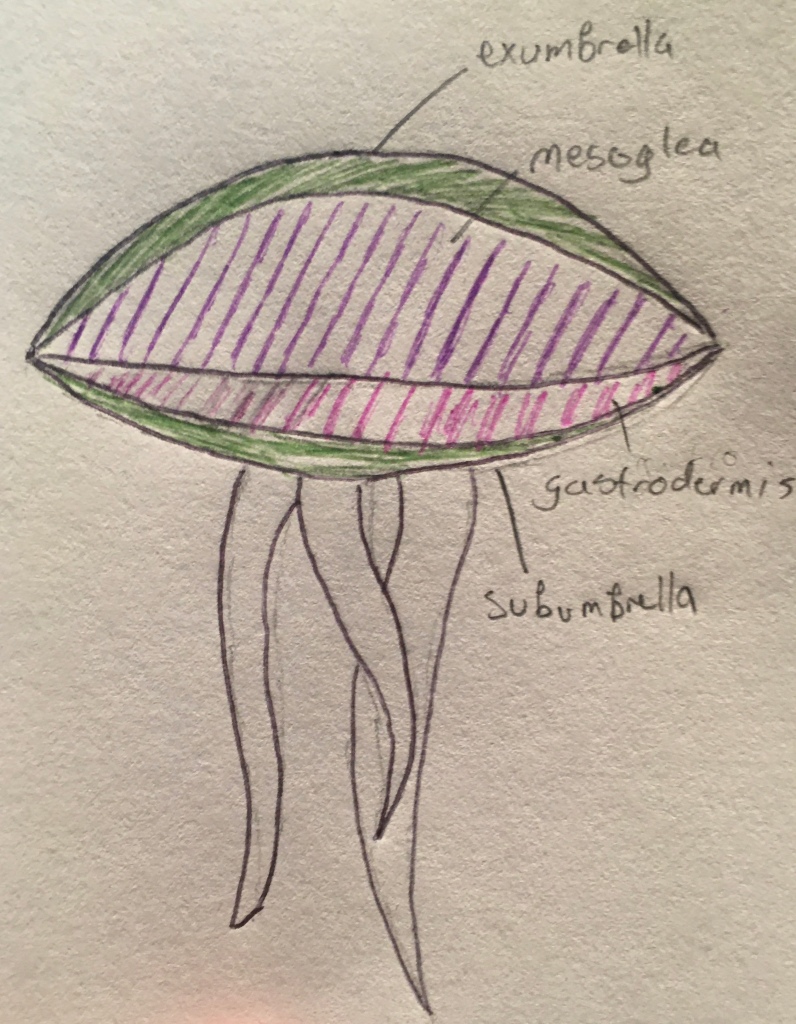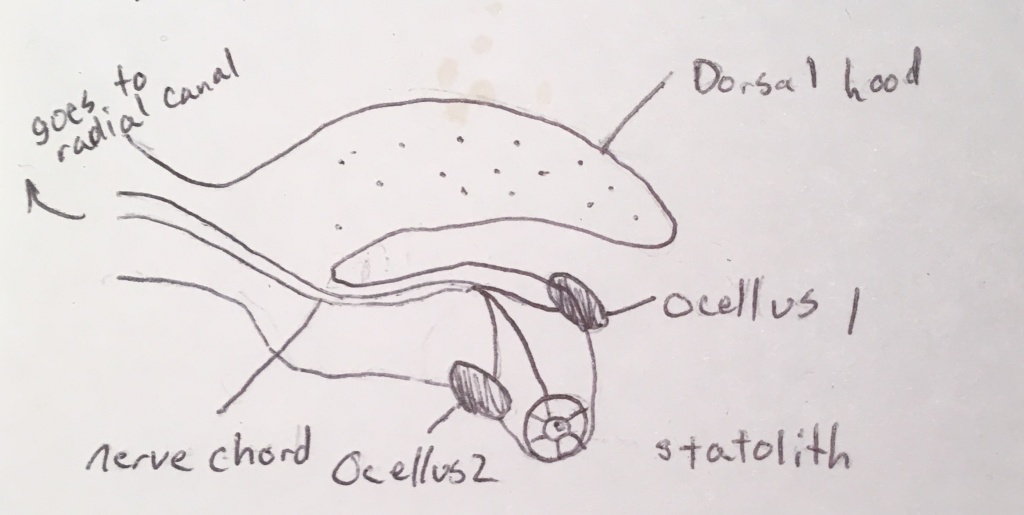In out blog posts attention is sometimes drawn to the common Aurelia. We usually refer to the Aurelia when drawing comparison or outlining a connection between the A. aurita and another jellyfish. In this post we want to explore this textbook beauty.

Taxonomy:
The Aurelia aurita is part of the Ulmaridae family, the same one as Deepstaria, Tiburonia, and Stygiomedusa scyphozoans. It has similar characteristics to these relatives and, also like them, is famously found across the world’s oceans.
It is almost impossible to distinguish between members of the Aurelia genus as they all look the same. The most accurate way is genetic sampling, and that is where most differenced and data from individual species is collected. This post is more about the Aurelia genus, because a lot of the information is applicable to multiple(if not all) species.
Description:
The Aurelia is a small disk, usually 4-8 inches (10-20 cm.) in diameter. The surface of the jelly is soft, smooth, and jelly-like in texture, a textbook jellyfish. Though the Aurelia seems fairly common, it does have a secret superpower that will be explored later.
The Aurelia is almost like a sandwich in lateral appearance. There are two layers of ‘skin’ material that line the exterior of the jellyfish. The bottom layer of skin the the subumbrella, this layer supports the middle section of the jellyfish’s body. Moving up, the next layer is the gastrodermal layer. This layer diffuses oxygen from the ocean water and distributes it to the gastrovascular canals.

Here is a lateral diagram of a Jellyfish. Each different layer of the bell is colored.
The Aurelia is almost like a sandwich in lateral appearance. There are two layers of ‘skin’ material that line the exterior of the jellyfish. The bottom layer of skin the the subumbrella, this layer supports the middle section of the jellyfish’s body. Moving up, the next layer is the gastrodermal layer. This layer diffuses oxygen from the ocean water and distributes it to the gastrovascular canals.
Above the gastrodermis is the mesoglea. The mesoglea is a thick layer that makes up most of the jelly’s mass. It is soft and malleable, and would fall apart without the exumbrella and subumbrella to keep it in place. The exumbrella is the same as the subumbrella, just on top of the jellyfish. All of these layers have to be mostly water and permeable to water so that it can pass through the gastrodermis and the jelly can respire.

The Aurelia also has a sensory structure called a rhopalium. This is a cluster of basic sensory organs, usually ocelli (basic light-sensing organs) and statoliths. This cluster is locate in between flaps in the jellyfish’s bell. The cluster also controls movement speed of the jellyfish. Aurelia usually has 4 rhopalia
Underneath the bell there is a velarium which protrudes from radial canal. It helps propel the jellyfish when it moves. The ring canal runs along the circumference of the bell, it connects the rhopalia. The ring canal split off into radio canals that run to the center of the bell.
It is important to note that this basic anatomical formula is true for most scyphozoans, it just easier to explain with the Aurelia because of its simplicity.

| g. | gonad |
| g.v.c. | gastrovascular-canal |
| r. | rhopalium |
| r.c. | ring canal |
| r.a.c. | radio canal |
| g. | gonad |
| mes. | mesoglea |
| v. | velarium |
| sto. | stomach |
| m. | mouth |
| o.a. | oral arms |
| t. | tentacles |
Eternal Youth:
You may have heard rumors about the Aurelia‘s famous cousin Turritopsis dohrnii, the Immortal Jellyfish. While the T. dohrnii could actually live forever, the common Aurelia has a trait similar to that of eternal youth. We will be doing a post about the Immortal Jellyfish in the near future.
Some cnidarians have evolved a sort of cellular metamorphosis, where a nerve cell could metamorphize into a gastrovascular-canal cell. This works because some cnidarians have evolved specialized cells that act like stem cells. The process is very much shrouded in mystery, but the effects are apparent.
When an Aurelia is in a section of ocean with scarce food, the Aurelia will shrink in diameter. It will loose mass and could possible eat or convert ‘lost’ cells into energy. This is part of the reason that species identification is so difficult within this genus. Is that a new species, or a shrunken A. aurita?
Either way, this genus of jellyfish is capable of living up to 20-30 years in captivity. Considering they are only supposed to live for around 12 months in the wild, 20 years is pretty good.
Niches & Spawning:
A. aurita is a food source for many pelagic life forms in the ocean. It is often eaten by traveling sea turtles, other jellyfish, and even people. Aurelias are rich in fatty acids and proteins and make a great sustainable food source.
The Aurelia actually plays an important role in the life of the Lion’s mane jellyfish. It acts a a stable food source for the developing medusa. A juvenile Lion’s Mane can occasionally be seen dragging an Aurelia almost 4 times its size.
Aurelias use the normal jellyfish lifecycle of broadcast spawning. When a sperm and egg cell meet, a nymph is created. It then attaches to a hard surface and buds into a jellyfish producing polyp.
Aurelia nymphs and polyps are among the most common found on oceanic and costal infrastructure. One study in Japan found almost 100 Aurelia polyps per 40 square centimeters of steel on a coastal bridge, but we’ll get to jellyfish overpopulation in a future blog post.
In any case, we hope you have enjoyed this post about one of the most common and special types of jellyfish. Have a great day.
3 thoughts on “Moon Jellyfish: Aurelia aurita”